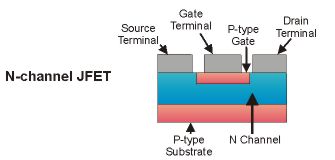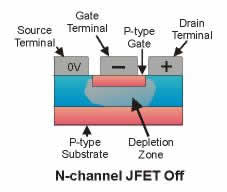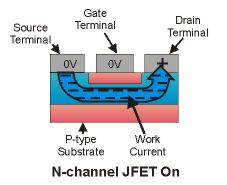
|
|
Field Effect TransistorsPart 1: Junction FETThe junction FET takes advantage of the peculiarities of the PN junction to make a more efficient transistor. The source and drain leads are connected at either end of a layer of p-type or n-type semiconductor (n-channel or p-channel). The gate which controls the flow of current through the channel always reverse biased so that very little current flows through the gate.
The illustrations here show an N-channel JFET. To turn off the transistor, a negative voltage is applied to the gate. The negative voltage repels the free electrons in the N-channel, effectively shutting off the flow of electrons from source to drain.
When the negative voltage on the gate is removed, the electrons can flow unimpeded towards the positive voltage on the drain. Although JFETs are far more efficient bipolar transistors, the MOSFET improves efficiency still further. Symbolspace space space space
|


